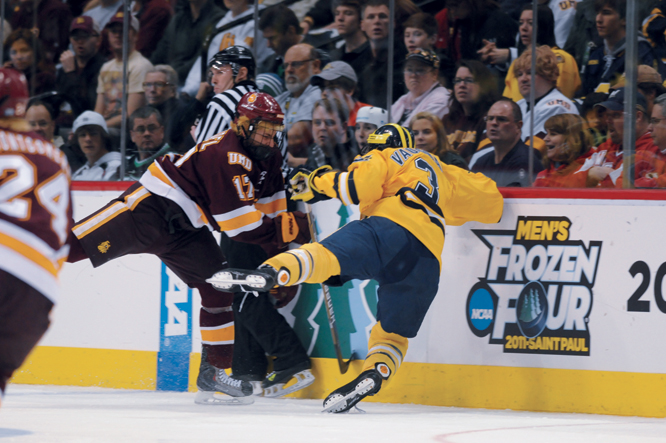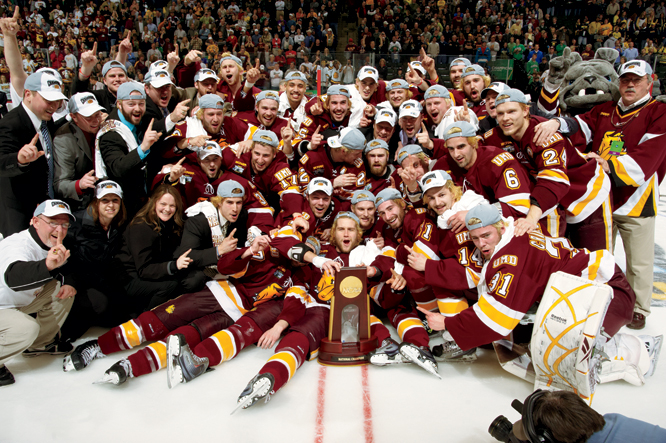28-Days-to-Lean Meal Plan
With the right plan and the right discipline, you can get seriously shredded in just 28 days.
Read article
Blake Palmer picked one hell of a year to start his new job as the strength and conditioning coach for the University of Minnesota-Duluth men’s ice hockey program. In Palmer’s rookie year manning the weight room, the Bulldogs won the school’s first NCAA Division I National Championship last April with an epic 3–2 overtime win over Michigan.
Backed by 81 years of hockey tradition—and boasting alumni like Brett Hull and assistant coach Derek Plante—UMD is typically at least in the hunt come Frozen Four time. It wasn’t until last season, however, that the Bulldogs managed to take center stage on a national scale. Here’s how Palmer helps the defending champs get things done off the ice.
Hockey’s skill-set requirements are unique among sports, and there are few if any experiences as intense—and intensive, in terms of energy system demands—as a typical 60-second shift. Players must express both power and endurance simultaneously during shifts, a combination Palmer addresses with an emphasis on simplicity and teaching.
“It’s not necessarily your philosophy that gets things done,” he says. “You don’t have to do tons of exercises. You just have to find what you do, and do it well.”
What the Bulldogs do, and do well, are the Olympic lifts. Palmer believes athletes are built from the ground up. Without his legs underneath him throughout the course of a game, a hockey player is in serious trouble, so the main idea at UMD is to focus heavily on cleans and squat variations to build the kind of lower-body strength that lasts through shifts, games and entire seasons.
When it comes to cleans, Palmer says he’s more concerned with bar speed and technique than with weight room numbers. “If you’re doing a clean and doing it wrong,” he says, “and you’re doing everything outside of proper technique to get the bar up there using your upper body, the lift isn’t doing what it’s supposed to do.”
To that end, Palmer advocates a teaching progression adapted from the Chinese. Instead of using the American style of learning to clean from a hang and then later progressing to a floor start, Palmer’s athletes start from the floor, deadlifting with a dowel. From there, they work their way up to a technically correct full clean.
“The benefits are phenomenal,” Palmer says. “For hip speed and hip power, there’s nothing better than Olympic lifting to strengthen that area. You see triple extension—the knee, the hip, and the ankle—in every sport, and there aren’t many exercises that can simulate that.”

To further enhance his players’ lower-body strength, Palmer has the Bulldogs squat at least three days per week in the off-season, alternating between front and back squatting. This seems like a lot of work, but Palmer says it’s more high frequency than high volume—with most movements, including the Olympic lifts, never exceeding five reps per set.
Along with this steady diet of squats, UMD players will do plenty of groin injury prevention work, focusing primarily on front and side lunges. “Hockey players have a lot of issues with the groin,” Palmer says. “When there’s soft ice, we address that with the extra work.”
One unique move Palmer also learned from the Chinese is a 90-degree isometric front squat hold where players maintain a parallel squat position with a weight on their backs for time. Their legs burn, lactic acid accumulates, and in terms of mental toughness, Palmer says, the exercise simulates the feel of an actual hockey shift.
There’s not a lot players can do off-ice in Duluth once the weather starts to turn colder. In the summer, they’re treated to running the hills of Lyons Street—similar in grade to San Francisco streets. In winter, however, Palmer prefers stationary bike work—specifically with a grueling challenge workout where players
are called upon to burn 500 calories in 30 minutes.
“It’s not necessarily a big scientific thing,” Palmer says. “They’re just working their bag off. They know they’re going to be tested on it when they come in and when they leave, so it’s a mental toughness thing for them.”
Palmer says anyone with questions can check out UMD’s overtime record. “Our guys had gas left in the tank. We won our national championship game in overtime, so we can let the training speak for itself.”